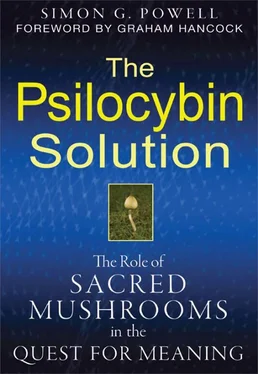And there you have it—the essential features of the brain’s highly sophisticated neuronal machinery in a nutshell. Information is transmitted and processed by the brain through the collective firing patterns of billions of neurons. Like the myriad on-off bit components of a computer, unbelievably large systems of neurons are able to carry out various computational processes and procedures, although the brain’s capacity to compute and literally think far outstrips the ability of any currently existing computer. The emergence of a sentient HAL-like or Skynet-like computer system that worries about being turned off or wants to wage war on us is unlikely. For whereas computers might be good at numerical calculation and other well-defined logical operations, they fail miserably when it comes to carrying out the types of thinking that we do all the time, like how to cross a really busy street while simultaneously contemplating a Shakespearean metaphor. Perhaps if computers were born into a society of computers, were able to form intricately detailed models of reality, and were able to continually rewrite themselves, then maybe they might eventually come to possess mindful characteristics. As it stands, what partly determines human consciousness and the human self are the vast webs of social and societal relations that impinge on us, the complex internal models of reality that we build and store, and the continual learning processes we undertake.
When considering the organized neuronal activity of the human brain, what we must actively strive to appreciate is the enormity of the system and the different patterns of impulse firing that the whole system can potentially embody. Not only are there billions of discrete neuronal firing devices, the amount of connectivity between them almost defies calculation. It has been estimated that each individual neuron can potentially pass on impulses to as many as ten thousand other neurons and may be in receipt of as many as fifty thousand potential impulses from other neurons. In our tree analogy, each tree would therefore be able to receive impulses and pass them on to vast forests of other trees.
Based on the above figures it has been calculated that the informational-storage capacity of the human brain is comparable to the content of all the books ever written. It is this bewildering capacity to process and store information that makes the human mind as rich and as complex as it appears to be. Without the brain’s ability to continually channel and organize billions of bits of information, the conscious human psyche as we know it could not exist.
This wealth of neuronal complexity that we all carry around in our big heads is staggering to say the least. At any one moment the entire network can be in an essentially infinite number of states of firing, and somewhere within this informational complexity lies our consciousness—who and what we are. Before dwelling on this obviously compelling mystery, there is yet more relevant data to consider. According to the outline of neurons given thus far, it might be assumed that they contact one another directly. We might suppose that the terminal fibers of neurons pass on their firing impulses directly to the dendrites of other neurons. In the tree analogy this infers that the branch tips of one tree touch the roots of other trees. However, this is not the case. What is more, the actual mechanism by which neurons relay their electrochemically mediated information to one another is the very place where psychoactive substances like psilocybin and your morning cup of caffeine-enriched coffee are believed to operate. To be more precise, the synapse is where it’s all at.
A Fantastic Journey into the Synapse
The synapse is the junction between two neurons, the place where they communicate, and it is arguably the most interesting feature of neuronal activity, for it operates with chemical substances that psychoactive drugs resemble. In fact, as we shall shortly see, most psychoactive drugs work by mimicking the endogenous chemical substances employed at the brain’s synaptic sites.
The chemicals employed at the neuronal synapse are called neurotransmitters since they are the chemical agents that allow neurons to transmit their electrochemical impulses to one another. Instead of one neuron directly fusing onto another, there is an intervening gap between them—the synaptic cleft—through which impulses must perforce be conveyed if they are to pass on their signal. This synaptic gap is so small that it can be discerned only with the aid of an electron microscope. Yet despite its microscopic size, a tremendous amount of chemical activity can and does occur in the synaptic cleft so that, in reality, the microscopic gap is more of a busy molecular chasm.
Basically, when an electrochemical impulse reaches the synapses at the end regions of the neuron’s terminal fibers (the tips of the branches in our tree analogy), it causes a neurotransmitter substance to be released into the synaptic cleft. After this substance has flooded the intervening synaptic space, some of its molecules bind themselves to special proteins called receptors located on the surface of the dendrites of the receiving neuron. After the binding has occurred, these receptors cause changes in the biochemistry of the receiving neuron. These changes then alter the electrical properties of the neuron and, if a certain threshold of activation is met, the original impulse will be regenerated in this neuron and subsequently be passed on to other neurons.
To fully explain the scope, scale, and intricacy of synaptic information transmission, permit me to employ another picturesque analogy. Instead of a terminal fiber/dendrite synapse, think of two train tunnels that do not meet but have an intervening space of, say, ten meters between them. Furthermore, imagine that a train speeds along one of the tunnels at hundreds of miles per hour. This is akin to a high-velocity electrochemical impulse traveling along a neuron. Not dogged by track problems, this Intercity Electrochemical Impulse Express reaches the end of the tunnel and duly crashes onto specially constructed buffers. The dramatic impact upon the buffers causes a group of strategically placed gas canisters to explode, thus dispersing their gaseous contents into the gap between the two tunnels. The gases instantaneously diffuse across the gap and cause a reaction to occur in a stationary train situated at the start of the next tunnel. As soon as molecules of the gas reach the next train, a neat reaction occurs in which the engine roars and the train is off, at the same speed as the first train. Meanwhile the gas molecules in the gap are immediately mopped up (and then conveniently recycled) so that they do not cause the replacement train (that magically appears almost instantly to replace the one that just sped off) to start up also. And in the first tunnel the original train has also been removed in order to allow another to follow if need be.
This analogy captures in essence the manner in which information flows at a single synapse. Although one might argue that a speeding train is a physical thing and an electrochemical impulse is not strictly a physical thing, the most important feature is the activity of the system and its informational state at any given moment . We could equally imagine a speeding band of fluorescent light or even a speeding vortex of turbulent air traveling down the tunnels; it does not matter. What really matters is the informational state of the components of the system—their relations with one another. In the actual neuronal synapse these crucial relations are defined by the chemical constituency of the whole system, that is, where and what effects various neurotransmitters are having on the different parts of the synapse.
If the synapse is starting to sound ridiculously complex, we should also keep in mind that the synaptic transmission of an impulse outlined above takes place in no more than 100 microseconds . In this outrageously short space of time, hundreds of thousands of neurotransmitter molecules are released from the terminal fibers of one neuron, are diffused across the synaptic cleft, come to attach themselves to special receptors on the dendrite of the next neuron, cause an electrochemical impulse to be generated (or not), and are finally reabsorbed and recycled for further use by the first neuron. All this in one hundred millionths of a second! Truly the mind boggles at the very processes underlying its boggling!
Читать дальше










